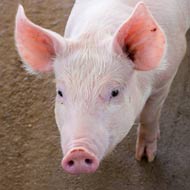Pioneering report finds ‘high level of pig welfare’

“This is a truly ground-breaking report, which is the result of the pig industry’s desire to obtain a real picture of the welfare of pigs of our farms".
A ground-breaking new welfare report has found evidence of high levels of welfare and stockmanship in the British pig industry.
The voluntary AHDB Real Welfare project is the biggest study of its type anywhere in the world, covering nearly 5.5 million pigs over a three-year period. It focused on the objective science-based indicators of animal welfare, rather than the environment in which animals are kept.
In the years Real Welfare has been in operation, all measures of physical injury except tail damage (which was already low) have fallen, according to the report.
Other key findings include:
- Only 0.07 per cent of pigs were identified as needing to be moved to a hospital pen for special treatment and, on more than three-quarters of farms, no pigs required hospitalisation
- Just 0.18 per cent of non-hospitalised pigs were lame and, on more than three-quarters of farms, no pigs were lame
- Only 0.14 per cent of pigs had severe tail damage and, on more than three-quarters of farms, no pigs had severe tail damage
- 70 per cent of pigs had their tails docked, lower than in most other European countries where tail docking is permitted
- 62 per cent of pigs had access to substrate, most of which was straw, and 32 per cent of pigs had access to objects
Commenting on the report, Zoe Davies, chief executive of the National Pig Association said: “This is a truly ground-breaking report, which is the result of the pig industry’s desire to obtain a real picture of the welfare of pigs of our farms. Overall, the results are very impressive and confirm what we already know about the pride that British pig producers take in ensuring their animals are properly looked after.”
Whilst 70 per cent of pigs had their tails docked, Davies said this figure is far lower than other major pig producing countries, where the level is often near 100 per cent. However, she added: “The industry is committed to continuing to drive further reductions in the number of pigs that have docked tails.”



 The BSAVA has opened submissions for the BSAVA Clinical Research Abstracts 2026.
The BSAVA has opened submissions for the BSAVA Clinical Research Abstracts 2026.